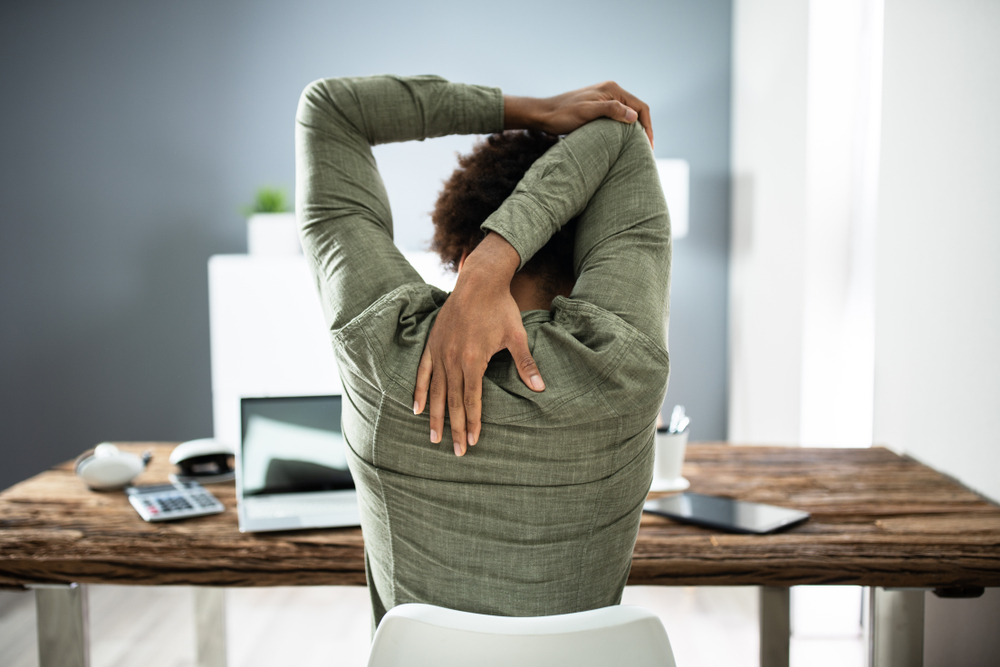With more people spending most of their days sitting, it’s no surprise that many individuals are experiencing back and neck pain due to poor posture.
Maintaining a healthy back and spine begins with adopting the correct sitting position.
Good posture begins with correctly aligning and supporting your back with the right amount of muscle tension.
River Stone Wellness is dedicated to helping you live a comfortable and pain-free life! To help you out, here are some ways that you can improve your sitting posture:
Why You Should Improve Your Sitting Posture
Poor posture is more than simply a bad habit!
It can lead to adverse health issues such as back pain, decreased energy, muscle tension, and other common ailments.
Maintaining a good posture while you are sitting has many health advantages, including:
- Reducing back pain. Slouching puts additional pressure on the ligaments, discs, and muscles in the spine, which can lead to lower back pain.
- Fewer headaches. Poor posture can cause muscle tension that can cause headaches, especially tension headaches that cause pressure and throbbing pain in the head, neck, and back.
- Increased lung capacity. Sitting with poor posture can compress the lungs and cause labored breathing and reduced respiratory function.
- Higher energy levels. Poor posture can hinder blood circulation and misalign bones and joints, causing fatigue and lower energy levels.
- Better form when exercising. Having good posture can help you maintain proper form when exercising, reducing your risk of injury and lower back pain. It will also help you see better results from your workouts!
It’s been shown that proper posture can also increase your confidence, especially when it comes to your physical appearance.
How to Improve Sitting Posture
Simply sitting in the optimal position may be difficult for you, and it may not be enough to correct your posture immediately.
Here are some ways that you can easily improve your posture and reduce your lower back and neck pain:
1. Stretching
Posture stretches are an amazing way to improve your posture – especially if you sit all day!
Try to include these posture stretches into your day-to-day routine:
- Neck Stretch: Leaning your head forward while sitting can put extra tension on your neck. Stretch your neck throughout the day by gripping the side of your chair with your right hand and using your left hand to gently tilt your head to the side. Hold for 15-30 seconds and repeat on the other side.
- Chest and Shoulder Stretch: Opening your chest can help your body better support your spine and neck. Interlace your fingers behind your back and lift your arms until you feel your chest stretching. Hold for 15-30 seconds and release.
- Back Extension: Ease the tension in your lower back by sitting back in your chair comfortably and upright. Lean back and keep your elbows wide to stretch your back and chest for 10-15 seconds.
2. Exercise
Posture exercises are also a great way to improve your posture. Try incorporating these moves into your workout routine:
- Cat Cow Pose: This yoga pose will help stretch and massage your spine and relieve tension. On your hands and knees, drop your abdomen down and extend your spine as you inhale. Exhale and arch your spine up while tucking your chin to your chest. Repeat slowly for one minute.
- High Plank: Planks can help you strengthen your shoulders and core to improve your sitting posture. On all fours, straighten your legs, lift your heels, and raise your hips. Engage your abs, arms, and legs as you straighten your back. Try to hold this position for at least one minute.
- Isometric Rows: Try this posture exercise to relieve pain and stiffness in your back and neck. Sit in a chair and bend your arms, so your palms are facing each other. Draw your elbows back into the chair and squeeze your shoulder blades together. Hold for 10 seconds and release back into the starting position. Repeat for one minute.
3. Myofascial Release
Myofascial release is a form of massage therapy that addresses pain in the myofascial tissues (the membranes that support, wrap, and connect your muscles).
It can be used to open up your movements and improve your postural balance. Restrictions in the fascia can lead to bad posture and restrict nerves and blood vessels, leading to pain.
Myofascial release can also help you increase your perception of your body and the space around it, leading to a better awareness of your posture while you are sitting.
4. Chiropractic
Chiropractic care is another option when it comes to addressing poor posture and related health issues.
A trained chiropractor can examine your posture to identify the cause of your issues and formulate a plan to help correct your posture and reduce your pain.
They will then make gentle adjustments to your shoulders to increase joint movement, reduce muscle tension, and ease you into adopting a better posture.
Click here to learn more about our chiropractic care services.
5. Massage
Massage therapy can help you improve your posture, especially if you are dealing with acute pain and tight muscles.
Massage will loosen tight muscles, increase joint mobility, and decrease stress to improve your posture and reduce pain.
Relaxation is another benefit of massage therapy, which can improve not only your physical health but your emotional health as well.
Click here to learn more about our massage therapy services.
Book Your Appointment Today!
If you spend most of your days sitting, we encourage you to try out these tips to help improve your posture.
By combining at-home stretching and exercises with professional health services, you can ensure optimal posture and reduce pain and tension in your back and neck.
Our expert team at River Stone Wellness is here to help you achieve your posture goals!
Contact us today if you have any questions about improving your posture, or book your appointment to get started.


